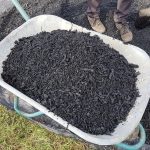Nitrogen in plants
Nitrogen is an essential macronutrient, which all plants require for proper growth. It is an important constituent of the chlorophyll molecule, nucleic acids and proteins.
Nitrogen is abundant in the atmosphere and comprises about 78% of its content. Nitrogen is also a constituent of organic matter in the soil. However, atmospheric and organic nitrogen cannot be directly used by plants. In order for plants to absorb nitrogen, it has to be first converted into ammonium (NH4+) and/or nitrate (NO3–), which are the forms that are available for plant uptake.
NITROGEN AVAILABILITY TO PLANTS
The processes in which nitrogen is converted to available forms are fixation, decomposition, mineralization and nitrification.
Fixation – atmospheric nitrogen is absorbed by nitrogen-fixing soil bacteria which convert the nitrogen into ammonia, using an enzyme called nitrogenase. The ammonia is then converted to ammonium (NH4+), which can be used by plants.
Decomposition and mineralization are biological processes carried out by soil microorganisms, in which organic nitrogen is converted into inorganic form – ammonia and ammonium.
R-NH2 –> NH3 –> NH4+
The process and its rate are affected by soil temperature and moisture. Warm soil temperatures (20-35ºC / 68-95ºF) and moist, but aerated soils favor decomposition and mineralization.
Nitrification – Under aerobic condition and warm temperatures, ammonium is further oxidized to nitrate (NO3–) in a process called nitrification.
Nitrification involves two reactions:
2NH4 +3O2 –> 2HNO2 + 2H+ + 2H2O (carried out by Nitrosomas).
2HNO2 + O2 –> 2NO3– + 2H+ (carried out by Nitrobacter).
NITROGEN UPTAKE BY PLANTS
As mentioned above, plants absorb nitrogen mainly as ammonium and nitrate. A mixture of both forms is usually beneficial.
These two nitrogen forms differ in their metabolism in the plant, in which they are converted to amino acid. Ammonium is metabolized in the roots and requires more oxygen, while the metabolism of nitrate takes place in the leaves.
In addition, the uptake of ammonium and nitrate affects differently the root environment and uptake of other nutrients. For example, chlorides competes with nitrate on uptake, since both carry a negative charge. In the same way, potassium and other positively-charged nutrients compete with ammonium.
NITROGEN DEFICIENCY SYMPTOMS IN PLANTS
Nitrogen deficient plants exhibit poor growth. Older leaves become pale green and smaller, as a result of reduced chlorophyll content. At a more advanced stage of the deficiency the entire plant becomes yellow and leaves drop.
NITROGEN FERTILIZERS
Sources of nitrogen applied in agriculture include both mineral fertilizers, as well as organic fertilizers.
Organic nitrogen sources
Organic nitrogen fertilizers include manure, compost and other organic products, such as blood meal, bone meal and seaweed.
Manure is organic matter derived from animal feces. For example, Guano is made of excrements of seabirds and bats. A typical nitrogen content in Guano is about 10-16% N.
Livestock manure typically contains 0.5-2.2% nitrogen, depending on the animal from which it was obtained and its diet. Note that nitrogen content may be presented on a dry weight basis or on a fresh weight basis.
Using fresh manure increases the risk of contamination of the produce as a result of pathogens that might be present in the manure.
Compost is a decomposed organic matter, which can includes plants, manure, eggshells etc. It is more stable than manure, releases nitrogen and other nutrients more slowly over time, improves soil structure and can suppress plant diseases and pests.
Mineral nitrogen sources
Mineral nitrogen fertilizers contain high concentration of available nitrogen in the form of ammonium, nitrate and urea. Fertilizers may contain one or all of these forms. The fertilizer may contain only nitrogen, or nitrogen in combination with other nutrients, such as potassium, calcium, sulfate and phosphate.
The best fertilizer source of nitrogen for a crop will depend on various factors, such as soil properties, temperature and growth stage of the crop.
Examples of nitrogen fertilizers:
Anhydrous ammonia
- Formula: NH3
- Composition: 82% nitrogen.
- Pressurized gas, there must be injected into the soil.
Ammonium nitrate
- Formula: NH4NO3
- State: Solid
- Composition: 17.5% N-NH4 , 17.5% N-NO3 (34% total nitrogen)
- Available also as a liquid, at lower concentration
- Solubility: 1920 g/liter at 20ºC
- Formula: a solution of urea CO(NH2)2 and ammonium nitrate NH4NO3
- Composition: 28-32% Nitrogen
- State: liquid
Urea
- Formula: CO(NH2)2
- Composition: Solid 46% Nitrogen
- State: Solid
- Solubility: 1200 g/liter at 20ºC
- Available also as a liquid, at lower concentrations
Ammonium sulfate
- Formula: (NH4)2SO4
- Composition: 21% Nitrogen, 24% S
- State: Solid
- Solubility: 750 g/liter at 20ºC
Mono ammonium phosphate (MAP)
- Formula: NH4H2PO4
- Composition: 12% nitrogen, 61% phosphorus as P2O5
- State: Solid
- Solubility: 364 g/liter at 20ºC







